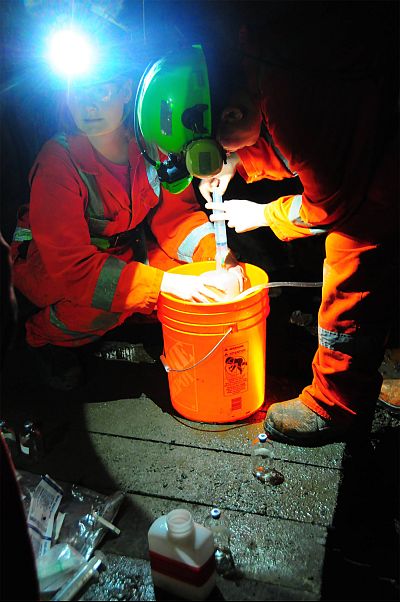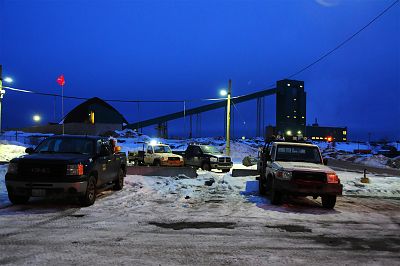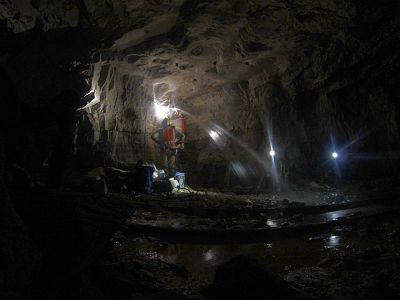The rock-eating, sulfur-breathing microbes have scientists wondering what other strange creatures dwell deep below Earth's surface.
Something odd is stirring in the depths of Canada's Kidd Mine. The zinc and copper mine, 350 miles northwest of Toronto, is the deepest spot ever explored on land and the reservoir of the oldest known water. And yet 7,900 feet below the surface, in perpetual darkness and in waters that have remained undisturbed for up to two billion years, the mine is teeming with life.
Many scientists had doubted that anything could live under such extreme conditions. But in July, a team led by University of Toronto geologist Barbara Sherwood Lollar reported that the mine's dark, deep water harbors a population of remarkable microbes.
The single-celled organisms don't need oxygen because they breathe sulfur compounds. Nor do they need sunlight. Instead, they live off chemicals in the surrounding rock — in particular, the glittery mineral pyrite, commonly known as fool's gold.
"It's a fascinating system where the organisms are literally eating fool's gold to survive," Lollar said. "What we are finding is so exciting — like 'being a kid again' level exciting."
Lollar is excited not only because of the peculiar the mine's rock-eating life seems, but also because of the growing realization that strange forms of life might not be so peculiar after all. Scientists are starting to find similar microbes in other deep spots, including boreholes, volcanic vents on the bottom of the ocean and buried sediments far beneath the seafloor.
"The deep microbial realm reveals a biosphere that's more extensive, resilient, varied and strange than we had realized," said Robert Hazen, a mineralogist at the Carnegie Institution's Geophysical Laboratory in Washington, and co-founder of Deep Carbon Observatory, a global project to study the deep biosphere.
Cut off from light, air, and any connection to the surface, this shadowy realm seems more like an alien world than part of Earth. Hazen said exploring it could help us understand how life might have begun on other planets as well as on our own. We might even find alien-like creatures living undetected right beneath our feet.
Lots of life at the bottom
Lollar's work builds on a 2018 report by Deep Carbon Observatory scientists who tried to map the total extent of Earth's deep biosphere comprehensively for the first time.
In the eye-opening report, a team led by Cara Magnabosco, a geobiologist at the Swiss technical university ETH Zurich, estimated that some 5 x 10^29 cells live in the deep Earth: that's five-hundred-thousand-trillion-trillion cells. Collectively, they weigh 300 times as much as all living people combined. The team describes this hidden ecosystem as an "underground Galapagos."
The denizens of the deep are an exotic bunch even beyond their appetite for solid rock. One species, the microbe Geogemma barossii, can live at temperatures of 250 degrees Fahrenheit — well above the boiling point of water and close to the theoretical limit at which vital organic molecules start to disintegrate.
Separate studies of material drilled near the Mariana Trench in the Pacific Ocean hint that some organisms could be living six miles below the seafloor, limited only by the heat at such tremendous depths. Laboratory experiments show that some microbes can tolerate pressures 20,000 times higher than the air pressure at sea level, meaning that there are almost certainly more extreme ecosystems out there than the one in the Kidd Mine.
"We're finding that we don't really understand the limits to life," Lollar said.
The pace of existence in the deep also seems radically different from that on the surface. In ancient environments like the trapped waters at the bottom of the Kidd Mine, food and energy are scarce. To compensate, cellular metabolism slows almost to a standstill.
"Many of the microbes may survive for thousands of years or more without dividing, just replacing their broken parts," said Karen Lloyd, a University of Tennessee microbiologist who studies life at the bottom of the ocean.
There are so many deep microbes that, despite a seemingly lazy existence, they collectively exert a huge impact on their habitats. For instance, a community of cells on the ocean floor consume methane gas that bubbles up from ancient sediment. "Deep subsurface microbes eat massive amounts of methane that would otherwise be released," Lloyd said, helping curb atmospheric levels of a potent greenhouse gas.
Back to beginnings
One of the big questions facing Lollar is how the deep-life community at the Kidd Mine is related to those found in other mines or stretched out beneath the oceans. "The number of systems we've looked at so far really is limited," she said, "but they probably had a single origin at some point in life's 4-billion-year history."
If so, there should still be clues about when and how life first colonized the deep.
Fossils show that surface life has changed enormously over billions of years, but slow-motion deep life may retain much of its primitive characteristics. That's especially true at the Kidd Mine, which is in one of the oldest, most stable portions of Earth's crust. (The rock in and around the mine have lain undisturbed for 2.7 billion years, and have been cool enough to support life for at least 2 billion years.)
Lollar wants to sequence the genes of the Kidd Creek microbes and then do a 23andMe-style analysis to unravel their kinship to other residents of the deep Earth: Are they all still close relatives, or have they diversified and adapted significantly to their local environments? It's a delicate project, but she hopes to have results within a year or two.
Such studies could offer hints about where life first arose on Earth. Charles Darwin imagined the beginning might have occurred in a warm little pond, but "there's absolutely no reason why it could not have been a warm little rock fracture," Lollar said. In many ways, she noted, sulfur-breathing microbes living beneath thick, protective layers of rock would have been well suited to the brutal conditions on our planet when it was young.
Another, even wilder possibility is that life originated more than once, with other forms still surviving somewhere on Earth. "We've literally only scratched the surface of the deep biosphere," Hazen said. "Might there be entire domains that are not dependent on the DNA, RNA and protein basis of life as we know it?" Perhaps we just haven't found them yet.
Paul Davies, a physicist at Arizona State University, has long advocated systematic searches for such "shadow life." The recent forays into the deep biosphere show how it might be done. Since known organisms cannot survive above 250 degrees Fahrenheit, Davies suggests going to extreme environments (around undersea volcanic vents, for instance) and checking for anything that appears alive at temperatures around 300 to 400 degrees Fahrenheit.
"That would stand out as a candidate for shadow life," he said.
Ever cautious, Lollar points out that she hasn't found any evidence of shadow life at the Kidd Mine. But she heartily agrees that scientists need to keep a wide-open mind about what could be lurking within the deep world: "We see only what we look for. If we don't look for something, we miss it."
Want more stories about the environment?
- A massive raft of volcanic rock could be heading toward Australia. That could be good news.
- Scientists ventured inside a rare 'fire cloud.' Here's what they found.
- Airplane contrails contribute to climate change, and the problem is about to get worse
Sign up for the MACH newsletter and follow NBC News MACH on Twitter and Facebook and Instagram.














